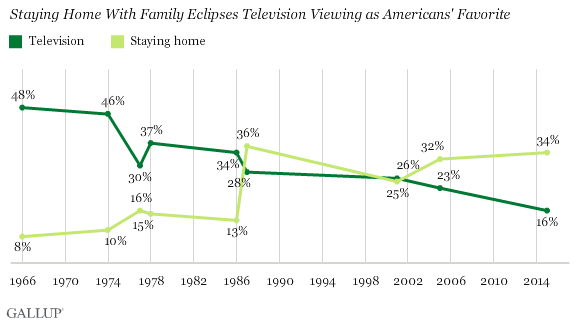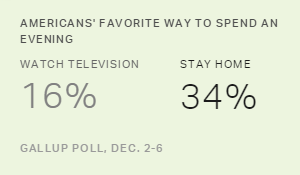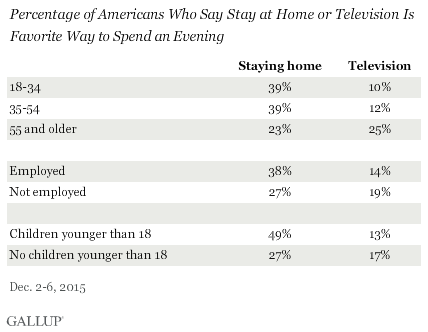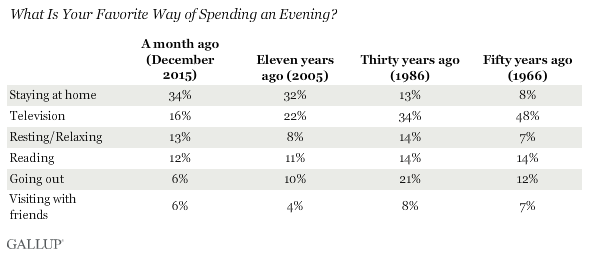By Jim Norman and Glynn Wilson –
WASHINGTON, D.C. — Television viewing was once so beloved by Americans that nearly half said it was their favorite thing to do at night. The latest public opinion survey shows night time TV is now less popular than ever, even with all the new choices between the major networks, cable and satellite and Web services such as Netflix.

Fifty years ago in the 1960s, when TV was the new mass medium of choice, 48 percent of the American public said it was their “favorite way of spending an evening.”
But even as the choices for television programming have expanded and diversified, the number of Americans who loyally turn to the tube for news and entertainment has declined steadily through the decades and now stands at a record-low 16 percent.

The top choice for U.S. adults when asked how they like to spend an evening is “staying home,” with a growing 34 percent of Americans saying this now, according to Gallup. As watching TV dropped in popularity through the years, “staying home” mentions soared — from 5 percent in 1966 to 16 percent in 1977, then 36 percent in 1987. After dropping back to 25 percent in 2001, it climbed to 32 percent in 2005.
Resting and Relaxing was the choice of 13 percent. Another 12 percent mentioned reading.

The previous low for television viewing — which also includes mentions of watching DVDs or videocassettes — was 23 percent in 2005, the last time Gallup asked the question. That was down from 26 percent in 2001.
Staying home with the family is the favorite thing to do at night for American parents and workers under 55. Television is still the favorite thing to do among 25 percent of those 55-and-older.
The percentage of U.S. adults who favor spending their nights reading, relaxing or visiting with friends has, for the most part, changed little over the past half-century, according to Gallup.
However, going out for the night — whether to dine, see a movie, go dancing or go to bars — grew substantially in popularity between 1966 and 1986, only to take a steep dive in the new century.

Gallup’s Bottom Line
Gallup’s question on Americans’ favorite way to spend an evening serves as a barometer of changing lifestyles.
“It has captured the steady descent of television as the nation’s favorite evening activity,” Gallup says. “Perhaps most tellingly, it has illustrated the changing mindset of Americans who have embraced staying at home.”
Many factors could be behind the shift away from TV as a top choice, including fear of terrorism in the wake of 9/11, a perception due to heightened media coverage that crime is on the rise, and a lack of willingness on the part of many to go out and spend money since the Bush Great Recession of 2007-2009.
“Television is now only one of many screens available to U.S. adults,” Gallup says, “and with Americans looking at smartphones and tablets on a near-constant basis throughout the day, the idea of sitting down to watch TV at night as a special thing to do may have lost its glow over the years.”
Survey Methods
Results for this Gallup poll are based on telephone interviews conducted Dec. 2-6, 2015, on the Gallup U.S. Daily survey, with a random sample of 824 adults, aged 18 and older, living in all 50 U.S. states and the District of Columbia. For results based on the total sample of national adults, the margin of sampling error is plus or minus 4 percentage points at the 95 percent confidence level. All reported margins of sampling error include computed design effects for weighting.
Each sample of national adults includes a minimum quota of 60 percent cellphone respondents and 40 percent landline respondents, with additional minimum quotas by time zone within region. Landline and cellular telephone numbers are selected using random-digit-dial methods.













